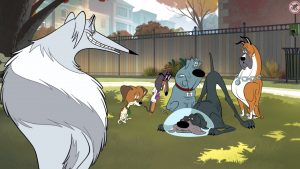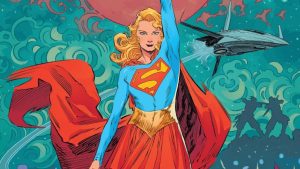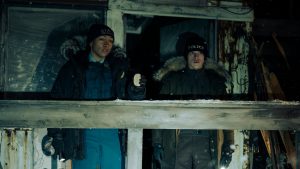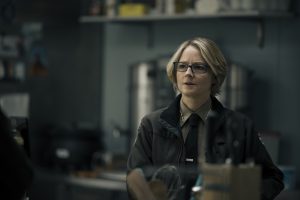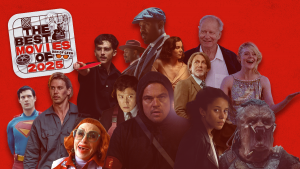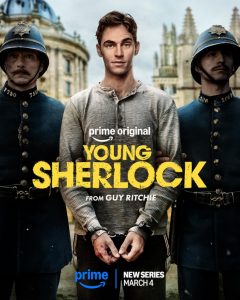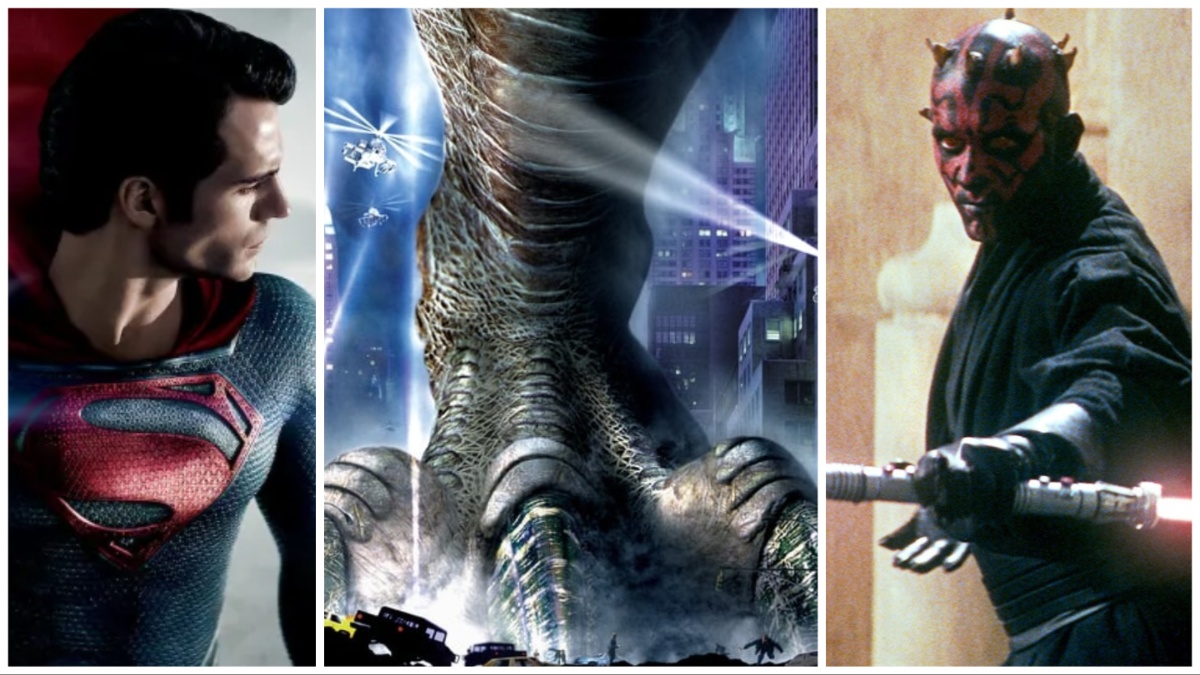
Even in this age of instant YouTube gratification, movie trailers are a big deal. They get us hyped for an upcoming project by making promises that the eventual film will (hopefully) pay off. The best sizzle reels are even able to do this by giving a taste of things to come without ruining any surprises or plot twists. Think about the teaser for Alien with its cracking egg and unnerving siren sound, or the deft use of a choral version of Radiohead’s “Creep” in the classic promo for The Social Network. Both of those examples speak to the haunting nature of their movies while allowing space for the film to stand on its own down the road.
But some trailers do their job too well. Some trailers outdo the movies they advertise, sometimes because the film has a concept too shallow to sustain more than three minutes, and sometimes because the trailer editors can do their job better than the director. Here are 16 trailers that stand above their source movies, providing a much more satisfying experience in a much shorter amount of time.
King Kong (1976)
When the first King Kong hit theaters in 1933, it truly did feel like the eighth wonder of the world. The giant gorilla seemed real as far as ’30s audiences were concerned. Look at it interacting with poor Fay Wray and swatting at real biplanes! So when the ever grandiose Dino De Laurentiis decided to remake the film for modern day, of course he leans into the special effects. Although the above clip largely leaves the complete Kong hidden from view, it does show off the updated effects from Carlo Rambaldi and Rick Baker.
Where the trailer promised thrills and wonder, the movie delivered a self-serious drag. Screenwriter Lorenzo Semple Jr. may have made his name with the goofy Batman TV series, but he burdens King Kong with environmentalist themes en vogue at the time. The plot about an unscrupulous oil exec (Charles Grodin) lacks the punch of the 1933 movie’s self-reflexive look at the entertainment industry. Journeyman director John Guillermin stages the adventure scenes well, but he can’t coax compelling performances out of leads Jessica Lange or Jeff Bridges.
Exorcist II: The Heretic (1977)
Not only is 1973’s The Exorcist one of the scariest movies of all time but it has one of the most unnerving trailers ever released. The promo features explosive dissolves of photo negative images from the film, assaulting the viewer and replicating the sense of overwhelming dread elicited quite differently by the finished film. The trailer for the sequel The Exorcist II: The Heretic also replicates the feeling of watching that movie. But The Heretic is a far worse and weirder.
“Now, the struggle between good and evil goes on” intones the classic 1970s trailer voice, followed by half-second snipptes of shots from the film, set to psychedelic freak rock. In isolation, these images manage to unsettle even the most steely viewer. Jumping from locusts to Father Lamont (Richard Burton) in a space-age doctor’s office to Regan (Linda Blair) tap-dancing, the viewer has no idea how to make sense of what they see. Unfortunately, director John Boorman does make sense of the images, with a plodding film that treats its absurd plot with stone-faced seriousness.
Magic (1978)
Although this list lends itself to unquestionably bad movies, that’s not the case for every entry, such as Magic. Working from a William Goldman script, the venerable English director Richard Attenborough crafts a creepy, moody film about troubled ventriloquist/stage magician Corky Withers (Anthony Hopkins) and his dummy Fats. The movie drags in some places but effectively walks a tightrope between psychological horror and moving tragedy, never fully revealing the truth about Fats.
However, the 30-second teaser/commercial spot for Magic promises a truly terrifying cinematic experience. The clip consists of nothing more than Fats sitting against a black background, staring directly at the camera as it pushes closer to him. Fats recites a creepy sing song rhyme, but the really chilling part is what happens after he shuts his eyes while the voiceover lists Magic‘s credits. His eyes open again and slowly look around, something so unnecessary and so unexpected that it suggests not an off-kilter character drama, but the most relentless horror.
The Dark Crystal (1982)
Okay, hear me out. Yes, The Dark Crystal has much to recommend: fantastic puppetry, amazing world-building, and striking cinematography. But it all comes in service of a generic quest narrative and stock characters. Look, I was five-years-old when the movie came to home video and of course the Skeksis scared me. But even that childhood trauma isn’t enough to make The Dark Crystal interesting to adults.
The trailer for The Dark Crystal avoids the problems of the finished film. “In a place outside time lies a mystical realm of sound and vision,” declares the narrator. And what visions they are, with Gelflings and Skeksis moving along ornate sets and fantastic settings, straight from Jim Henson‘s imagination. The romantic strains of Trevor Jones’ score makes even the most cynical viewer (read: me, today) long to visit. And that’s where The Dark Crystal works best, as an idea unrealized.
Friday the 13th Part VIII: Jason Takes Manhattan (1989)
Recently, a group of rabid Ana de Armas fans took the producers of the Danny Boyle film Yesterday to court, angry that the actress appeared in the trailer but never in the finished movie. The judge in that case dismissed the suit, but moviegoers in 1989 might have had a case. Because the trailer for the seventh and final Paramount Friday the 13th movie features something that doesn’t really occur in the film: Jason in New York City.
Written and directed by Rob Hedden, Friday the 13th Part VIII: Jason Takes Manhattan plays more like Jason on a boat than the big city massacre the title suggests. Most of the film involves Jason slaughtering high school seniors on a class trip from Crystal Lake to the Big Apple. When the boat finally lands, we do get a couple of shots of Jason (Kane Hodder) in actual New York, but most of it was shot in Vancouver, which doesn’t even feel like New York. In doing so, Paramount risked the wrath of the only thing scary than Mama Voorhees’ baby boy: slasher fans of the late ’80s.
Leprechaun (1993)
Maybe, Leprechaun was doomed from the start. After all, moviegoers of the early 1990s most associated leprechauns with breakfast cereal aficionados, even more so than the trickster figures of Irish folklore. No matter how great the make-up effects by Gabe Bartalos (and they are pretty great), it’s hard to find a little creature scary, especially if he lacks the numbers of the Gremlins or the Critters. In fact, studio Trimark Pictures figured as such, which is why they made writer/director Mark Jones insert more comedic scenes, such as the pogo stick kill, presaging the Leprechaun’s eventual journeys to the hood and back.
Still, the trailer for Leprechaun tries its best to convince viewers that they’re going to watch a scary movie. It downplays the worst parts of the films, actual full shots of Warwick Davis in a silly green outfit or Mark Holton’s ill-advised performance as Ozzie. Instead it makes deft use of a rushing POV camera and repeating sounds, foregrounding Jennifer Aniston as a pretty lady in peril. Did it look like a great horror movie? No, of course not. But it at least looked like a competent and thrilling movie, something not even the luck of the Irish could pull off for Leprechaun.
Godzilla (1998)
Like Leprechaun, the 1998 American Godzilla movie, directed by German Roland Emmerich, had a huge optics problem. It wasn’t that audiences associated the central character with a cartoon cereal mascot. Rather it’s that they transformed Big G into a giant Iguana, a poor replacement for the T-Rex style creatures we’d enjoyed for the past 54 years. And then there are all the problems that come with any Emmerich movie, including incoherent direction, dreadfully unfunny jokes (remember Mayor Ebert?), and too much attention on dull human characters.
None of that shows up in the trailer for Godzilla. Instead it does exactly what a good Godzilla trailer should do. It builds tension by showing signs of mayhem outside of the U.S. before moving to New York City, using thumping footsteps to signal the creature’s coming. Moreover, the trailer features some striking imagery, including a fantastic overhead shot of a face peering up from a sea of umbrellas. The trailer itself is a perfectly satisfying Godzilla film. The actual movie is not.
Star Wars – Episode I: The Phantom Menace (1999)
Okay, Star Wars – Episode I: The Phantom Menace doesn’t have that great of a trailer. It pretty much plays out the way you would expect a Star Wars trailer to work, with classic queues from the John Williams score and a mixture of familiar and new characters. We get a few comic moments from Jar Jar, an ominous statement from Natalie Portman’s Queen Amidala, and acceptable Star Wars jargon about Jedi and the Force.
Those all might seem familiar in this age of Star Wars content oversaturation. But in 1999, they felt fresh and exciting. The Phantom Menace was the first new Star Wars movie in over 15 years, since the relative high of Return of the Jedi. The fantastic imagery and snips of dialogue in no way revealed what we’d actually get in the film: wooden acting, plodding exposition about pretend economies, and so, so much Jar Jar slapstick. For a few blessed months, that trailer promised the teens and young adults of the late ’90s an amazing Star Wars movie—which is exactly how later generations inexplicably describe The Phantom Menace.
Wild Wild West (1999)
The Fall Guy aside, Hollywood has mostly moved out of its habit of making big budget adaptations of old TV shows that no one remembers. That wasn’t the case in the 1990s, and while the tactic did give us The Fugitive, The Addams Family, and Maverick, it also gave us The Beverly Hillbillies and Wild Wild West. Of course the real appeal of Wild Wild West wasn’t its 1960s predecessor, but another film from the 1990s, the previous Will Smith and Barry Sonnenfeld team-up, Men in Black.
The Wild Wild West trailer did everything it could to convince moviegoers that they were getting Men in Black Cowboy Hats. The always cool Will Smith struts around and trades banter with an older white guy, this time Kevin Kline, and the few shots we get of Kenneth Branagh’s Southern-fried baddie have shades of Vincent D’Onofrio‘s masterful Edgar. While Jon Peters probably cheered at the sight of the mechanical giant spider, everyone else felt betrayed by the actual movie, a painfully unfunny and zany romp that suggested that maybe Sonnenfeld and Smith couldn’t replicate the magic of their first movie together, something that Men in Black II would confirm a few years later.
Pearl Harbor (2001)
Every once in a while, someone lamenting the modern era of CG-heavy, superhero-infested action movies wishes for the return of Michael Bay‘s supremacy. The trailer for Pearl Harbor only fuels that nostalgia. The three-and-a-half minute clip channels Norman Rockwell by way of instantly iconic Americana: a young lad tossing a baseball while Zeroes fly past, boy scouts enjoying an early morning camping trip as the same weapons of death soar past, or Ben Affleck and Josh Hartnett looking like matinee idols under their floppy hair. All of it comes accompanied by a voiceover from Jon Voight as Franklin Delano Roosevelt, foregrounding the patriotic furor that would get supercharged by the end of 2001.
But Michael Bay is no Norman Rockwell, nor is he Joe Johnston, so all the classic Hollywood tropes fell flat in the eventual movie. All sheen and no substance, with an aesthetic best suited for soda-pop commercials, Bay throws every shot of Japanese planes and brave American pilots at the screen. He never sticks with one long enough to develop it though, nor with any character—which given the terrible performances by Affleck, Hartnett, and Kate Beckinsale, might be a good thing. Modern action movies may be bad, but Pearl Harbor proved that poor quality isn’t a modern invention.
Sin City (2005)
It might be hard to imagine now, but even a few years before the MCU launched in 2008, nerds just wanted to filmmakers to shoot the comic. After all, what are comic books but storyboards ready for filming? (To be clear, if you think that, please hit yourself in the head.) With that in mind, Robert Rodrugiez seemed like a cinematic genius when he did just that for Sin City, even getting the comic’s creator Frank Miller on board as a co-director.
In a way, it kind of worked. Sin City does translate the hyper-noir of Miller’s comics and does feature some striking images, like Marley Shelton’s eyes glowing when her cigarette is lit or Elijah Wood‘s hard white glasses obscuring any trace of humanity. All of those elements appear in the final trailer, along with some choice gritty lines and a rocking guitar score by Rodruigez himself. It’s frankly exhilarating and far better than the actual film, which ends up feeling cheap and silly, the exact opposite of the intended tone.
Quantum of Solace (2008)
Casino Royale gave viewers something only hinted at in previous James Bond movies, such as On Her Majesty’s Secret Service. A 007 with a heart and who had loved and lost and now reverted to anger. In the trailer for Quantum of Solace, we see glimpses of the next stage in that Bond’s journey. With the moody sounds familiar to the franchise playing, Bond (Daniel Craig) and M (Judi Dench) trade lines about revenge and pain and regret. The trailer even includes a funny line from a pre-Stranger Things David Harbour.
The actual movie Quantum of Solace isn’t not that, exactly. It does indeed feature Bond blending the personal and the professional as he teams with an equally bereaved woman (Olga Kurylenko) to take down the secret syndicate Quantum. However, a script that went through multiple drafts (eventually credited to Paul Haggis, Neal Purvis, and Robert Wade) and was stalled by the writer’s strike of 2007 ended up an incoherent mess. Worse, director Marc Forster proved utterly incapable of handling an action thriller, muddying the material with too many cuts and poor shot selections.
The Girl With the Dragon Tattoo (2011)
To be clear, David Fincher’s take on The Girl With the Dragon Tattoo is a good movie. Even those who prefer director Niels Arden Oplev’s Swedish adaptation of the Stieg Larsson novel must admit that Fincher’s bleak, chilly approach matches the tone of the material. Furthermore, Fincher gets electric performances out of Rooney Mara as hacker Lisbeth Salander and Daniel Craig as reporter/himbo Mikael Blomkvist.
But here’s the thing: no movie could live up to the trailer for The Girl With the Dragon Tattoo. Recalling the skills he developed while making classic music videos such as Madonna’s “Vogue” and “Express Yourself,” Fincher cuts a trailer that functions less as an advertisement for a feature film and more as a standalone work of sizzle. Set to a cover of Led Zepplin’s “Immigrant Song,” by composers Trent Reznor and Atticus Ross, with vocals by Karen O of the Yeah Yeah Yeah’s, the clip intercuts shots from the movie with a rapidly enclosing push in to a stately mansion. Even those who haven’t seen the movie or read the book know that the house contains something evil.
Man of Steel (2013)
Zack Snyder was not an unknown quantity when Christopher Nolan recommended him as the man to helm a series of Superman movies. It was a deliberate choice which attempted to follow in the footsteps of The Dark Knight trilogy, which had just made superhero movies respectable again. In addition to the comics adaptations 300 and Watchmen, Snyder had made a passion project with Sucker Punch and the weird animated film Legend of the Guardians: The Owls of Ga’Hoole. Yet none of these movies, not even the one with the owls, indicated that he would make a good Superman movie. Instead they suggested that he would make, well, the overly serious and unpleasant Man of Steel.
But for a few months, it looked like Snyder would pull it off. All three of the movie’s trailers emphasized Clark’s (Henry Cavill) existence as a man of two worlds, from the Americana of his pre-cape days to the hopes carried by his Kryptonian father Jor-El (Russell Crowe). Even when later trailers include some of the carnage and cynicism that would eventually sink the film, they all build to Superman taking flight, framing him as an ultimately inspirational figure. Although the trailers pointedly never say his name, they absolutely feel like a perfect modernization of Superman, something Man of Steel never achieves.
Thor: Love and Thunder (2022)
A great song covers a multitude of sins. Nothing proves that statement better than the trailer for Thor: Love and Thunder, the late-coming follow-up to the Taika Waittiti directed Thor: Ragnarok. The sublime sounds of Slash’s guitar on Guns N’ Roses’ “Sweet Child O’ Mine” signals everything people wanted from the MCU entry: wistful character beats, irreverent comedy, and electric nostalgia. Shots of Chris Hemsworth’s Thor palling around with the Guardians of the Galaxy implied a continuation of Avengers: Endgame-style team-ups, and Christian Bale cut an impressive figure as the villain Gorr the God-Butcher.
The trailer did have its moments of goofy fun, especially a gag in which Thor’s grinning mug comes from the side of the frame. But it really undersold just how much of Love and Thunder would consist of rapidfire cracks at the source material’s expense. Waititi directed the film like a teenager who grew too cool and handsome for his nerdy old friends, and takes every opportunity to mock the premise. The best sequence in the movie does feature a Guns N’ Roses song, but nothing else in the movie matches the delightful trailer.
The post Great Movie Trailers That Were Better Than the Actual Movies appeared first on Den of Geek.
